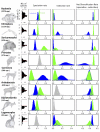Faster speciation and reduced extinction in the tropics contribute to the Mammalian latitudinal diversity gradient
- PMID: 24492316
- PMCID: PMC3904837
- DOI: 10.1371/journal.pbio.1001775
Faster speciation and reduced extinction in the tropics contribute to the Mammalian latitudinal diversity gradient
Abstract
The increase in species richness from the poles to the tropics, referred to as the latitudinal diversity gradient, is one of the most ubiquitous biodiversity patterns in the natural world. Although understanding how rates of speciation and extinction vary with latitude is central to explaining this pattern, such analyses have been impeded by the difficulty of estimating diversification rates associated with specific geographic locations. Here, we use a powerful phylogenetic approach and a nearly complete phylogeny of mammals to estimate speciation, extinction, and dispersal rates associated with the tropical and temperate biomes. Overall, speciation rates are higher, and extinction rates lower, in the tropics than in temperate regions. The diversity of the eight most species-rich mammalian orders (covering 92% of all mammals) peaks in the tropics, except that of the Lagomorpha (hares, rabbits, and pikas) reaching a maxima in northern-temperate regions. Latitudinal patterns in diversification rates are strikingly consistent with these diversity patterns, with peaks in species richness associated with low extinction rates (Primates and Lagomorpha), high speciation rates (Diprotodontia, Artiodactyla, and Soricomorpha), or both (Chiroptera and Rodentia). Rates of range expansion were typically higher from the tropics to the temperate regions than in the other direction, supporting the "out of the tropics" hypothesis whereby species originate in the tropics and disperse into higher latitudes. Overall, these results suggest that differences in diversification rates have played a major role in shaping the modern latitudinal diversity gradient in mammals, and illustrate the usefulness of recently developed phylogenetic approaches for understanding this famous yet mysterious pattern.
Conflict of interest statement
The authors have declared that no competing interests exist.
Figures



References
-
- Hillebrand H (2004) On the generality of the latitudinal diversity gradient. Am Nat 163: 192–211. - PubMed
-
- Mittelbach GG, Schemske DW, Cornell HV, Allen AP, Brown JM, et al. (2007) Evolution and the latitudinal diversity gradient: speciation, extinction and biogeography. Ecol Lett 10: 315–331. - PubMed
-
- Wiens JJ, Sukumaran J, Pyron RA, Brown RM (2009) Evolutionary and biogeographic origins of high tropical diversity in old world frogs (Ranidae). Evolution 63: 1217–1231. - PubMed
-
- Cardillo M, Orme CDL, Owens IPF (2005) Testing for latitudinal bias in diversification rates: an example using New World birds. Ecology 86: 2278–2287.
-
- Ricklefs RE (2006) Global variation in the diversification rate of passerine birds. Ecology 87: 2468–2478. - PubMed
Publication types
MeSH terms
LinkOut - more resources
Full Text Sources
Other Literature Sources

